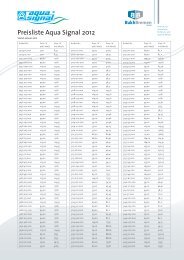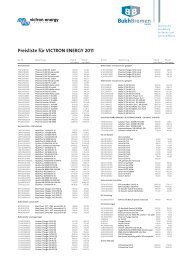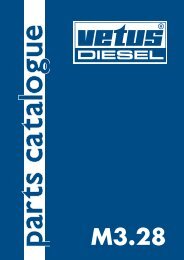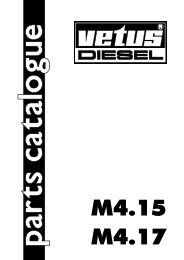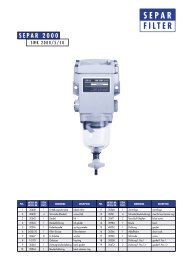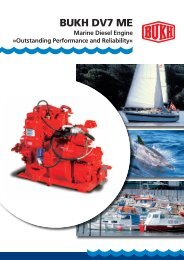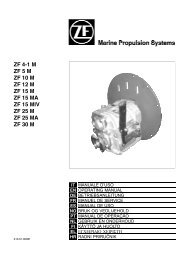5. mechanical installation - BUKH Bremen
5. mechanical installation - BUKH Bremen
5. mechanical installation - BUKH Bremen
Create successful ePaper yourself
Turn your PDF publications into a flip-book with our unique Google optimized e-Paper software.
HYDROGENERATOR CRUISING<br />
Instruction manual<br />
Version V1<br />
Revised 2<br />
Date Décembre 2010<br />
Author Matthieu Michou<br />
Contact contact@wattandsea.com<br />
Translation<br />
HYDROGENERATOR SERIAL NUMBER<br />
CONVERTER SERIAL NUMBER
TABLE OF CONTENTS<br />
1. CONGRATULATIONS 4<br />
2. SAFETY 5<br />
2.1. Mechanical hazard : 5<br />
2.2. Electrical hazard 5<br />
2.3. Installation 5<br />
2.4. Operation 5<br />
3. PACKAGE CONTENT 7<br />
4. TOOLS & SUPPLIES NOT INCLUDED 7<br />
<strong>5.</strong> MECHANICAL INSTALLATION 8<br />
<strong>5.</strong>1. Installing the propeller. 8<br />
<strong>5.</strong>2. Placing the machine on the transom 9<br />
<strong>5.</strong>3. Installing the cradle on the transom. 11<br />
<strong>5.</strong>4. Running a line of the immersion/lifting system 12<br />
<strong>5.</strong><strong>5.</strong> Removing the propeller 13<br />
<strong>5.</strong>6. Mounting the electronic converter 13<br />
6. ELECTRICAL INSTALLATION 14<br />
6.1. Three‐phases wiring of the hydrogenerator 15<br />
6.2. Connecting the converter to the batteries 16<br />
6.3. Replacing fuses 16<br />
7. INSTALLATION SUMMARY 17<br />
8. WARRANTY 18<br />
9. CHARACTERISTICS 19<br />
9.1. Technical characteristics 19<br />
9.2. How it works 20<br />
9.3. Performances 21<br />
10. MAINTENANCE 22<br />
11. SPARE PARTS 22<br />
12. F.A.Q. 23<br />
12.1. Operation 23<br />
12.2. Maintenance & repairs 23<br />
12.3. Docking or mooring 24<br />
W&S ‐ Manuel_GB_Cruise v1.2 page 2 by 24
BLUEPRINTS LIST<br />
Fig. 1: Package contents 7<br />
Fig. 2 : Shaft, propeller, plastic washer and M5 screw 8<br />
Fig. 3 : Installation on a 33’ Figaro II leant at 20° (CFD by CRAIN) 9<br />
Fig. 4 : Double <strong>installation</strong> on a Pogo40 (© CN STRUCTURES). 10<br />
Fig. 5 : Installation on a catamaran. (© OUTREMER CATAMARANS) 10<br />
Fig. 6 : Craddle dimensions 11<br />
Fig. 7 : Immersing/lifting lines path 12<br />
Fig. 8 : Device lifted in upper position 12<br />
Fig. 9 : Converter dimensions 13<br />
Fig. 10 : Drilling template 13<br />
Fig. 11 : Wiring 14<br />
Fig. 12 : Phase converter wiring plan. Arrows indicates phases in. 15<br />
Fig. 13 Hydrogenerator dimensions 19<br />
Fig. 14 : Output related to boat speed 21<br />
W&S ‐ Manuel_GB_Cruise v1.2 page 3 by 24
1. CONGRATULATIONS<br />
You own the most powerful hydrogenerator of its kind. Designed for transoceanic racing and<br />
cruising, this device will drastically change your energy management at sea and become<br />
your main source of power while sailing.<br />
Designed and made in France by:<br />
WATT&SEA SARL<br />
Le Sextant<br />
1 rue de la Trinquette<br />
17000 La Rochelle<br />
FRANCE<br />
www.wattandsea.com<br />
W&S ‐ Manuel_GB_Cruise v1.2 page 4 by 24
2. SAFETY<br />
“Safety first” was our goal in building the hydrogenerator. However precautions must be<br />
taken as when using any <strong>mechanical</strong> or electrical device.<br />
Keep in mind safety rules when installing and operating the hydrogenerator. Be aware at all<br />
times of hazards in operating the propeller.<br />
2.1. Mechanical hazard :<br />
While rotating, propeller blades might be dangerous. They are aluminum made and their<br />
edges can rotate up to 62 MPH (100km/h).<br />
At this speed, the tip of a blade is nearly invisible and can cause serious injury. Under no<br />
circumstances should you install the turbine where a person could come in contact with<br />
moving rotor blades.<br />
WARNING: WHEN PLACING THE HYDROGENERATOR, MAKE SURE THAT THE<br />
PROPELLER IS NOT WITHIN EASY REACH.<br />
DO NOT ATTEMPT TO STOP THE PROPELLER WITH YOUR HAND WHILE THE<br />
DEVICE IS WORKING.<br />
2.2. Electrical hazard<br />
Heat in wiring systems is often a result of too much current flowing through an undersized<br />
wire or through a bad connection.<br />
Batteries conduct very high intensity. Their cables might cause fire. A 50Amp fuse placed<br />
into the converter prevents this issue.<br />
WARNING: FUSES MUST BE REPLACED WITH THE SAME ORIGINAL MODEL<br />
WARNING: ALWAYS RAISE THE HYDROGENERATOR UP BEFORE WORKING ON IT<br />
2.3. Installation<br />
Please follow our guidelines before <strong>installation</strong>:<br />
� Keep safety in mind - Get helps.<br />
� Connect the batteries last.<br />
2.4. Operation<br />
� Check the support structure, blades and electric circuit on a regular basis.<br />
� Propeller blades are very sturdy though they might warp or break when running up<br />
against a hard immersed object.<br />
WARNING: NEVER TOUCH THE PROPELLER WHILE SPINNING<br />
WARNING: NEVER USE THE HYDROGENERATOR AS A LADDER STEP BECAUSE<br />
THE SHAFT MAY WARP.<br />
W&S ‐ Manuel_GB_Cruise v1.2 page 5 by 24
WARNING: ELECTRIC CONVERTER REACHES HIGH TEMPERATURE WHILE<br />
OPERATING.<br />
W&S ‐ Manuel_GB_Cruise v1.2 page 6 by 24
3. PACKAGE CONTENT<br />
Check the package content against the list below.<br />
1 HYDROGENERATOR<br />
1 THREE BLADE PROPELLER<br />
1 CONVERTER 12V OR 24 V<br />
1 SCREW CHC M4X16<br />
1 SCREW CHC M6X16<br />
1 INSTRUCTION GUIDE<br />
4. TOOLS & SUPPLIES NOT INCLUDED<br />
� 3 phase cable 3X2,5mm2 minimum<br />
� Quick Disconnect Terminals<br />
� Crimp pliers<br />
� Connectors for 3-phase cables<br />
� Outlet box PCV<br />
� Metric Allen wrench set<br />
� Hubs & screws<br />
� Gasket Ø 6mm<br />
Fig. 1: Package contents<br />
W&S ‐ Manuel_GB_Cruise v1.2 page 7 by 24
<strong>5.</strong> MECHANICAL INSTALLATION<br />
Your hydrogenerator is shipped partly in kit. Refer to the assembly drawing below, and<br />
follow the instructions. Please carefully read the instruction manual before proceeding to the<br />
<strong>installation</strong>.<br />
<strong>5.</strong>1. Installing the propeller.<br />
� Slide the propeller onto the shaft<br />
� Check that the electrolytic insulation washer is placed into its groove<br />
� Insert the CHC M5X20 screw, and tight it with a 4mm Allen wrench. We recommend<br />
coating the screw with block thread to prevent the screw from loosening.<br />
Fig. 2 : Shaft, propeller, plastic washer and M5 screw<br />
N Désignation<br />
2 Shaft<br />
8 Tri-blade propeller<br />
12 Insulation plastic washer<br />
21 Screw #CHC M5X16<br />
W&S ‐ Manuel_GB_Cruise v1.2 page 8 by 24
<strong>5.</strong>2. Placing the machine on the transom<br />
Choosing the right place for the machine is crucial to optimize its performance.<br />
Be careful to respect the following conditions:<br />
� Immersion depth:<br />
The recommended depth from surface to propeller axis is 30cm (12 inches). The machine<br />
comes with a profiled 1 meter aluminum bar that can be cut to fit any configuration.<br />
The deeper the device is located and the farther the propeller is from the hull wake, the<br />
better it is.<br />
However, the deeper the boom is, the more stress on mounting will result. In addition, the<br />
device will be harder to lift.<br />
We consider that a length of 1 meter (3.28 feet) is a satisfactory compromise that suits most<br />
<strong>installation</strong>s on monohulls.<br />
A shorter length is suitable on multihulls because they don't lean, or on very wide monohulls<br />
when a device is installed on each side.<br />
� Flow quality :<br />
A good water flow is crucial to a good output.<br />
. Example: <strong>installation</strong> using a long shaft (see drawing 3)<br />
. Example: <strong>installation</strong> using a short shaft (see drawing 4 & 5)<br />
NOTE: do not place the device in close proximity to the wake of rudder or<br />
saildrive.<br />
Whenever possible, install the device a few inches off the center of the boat.<br />
� Example of <strong>installation</strong> with a 1 meter shaft:<br />
Fig. 3 : Installation on a 33’ Figaro II leant at 20° (CFD by CRAIN)<br />
W&S ‐ Manuel_GB_Cruise v1.2 page 9 by 24
� Example of <strong>installation</strong> with shorter shafts (70cm):<br />
Fig. 4 : Double <strong>installation</strong> on a Pogo40 (© CN STRUCTURES).<br />
The hydrogenerators are placed parallel to the rudders but off their wakes.<br />
Fig. 5 : Installation on a catamaran. (© OUTREMER CATAMARANS)<br />
The hydrogenerator is placed parallel to the rudder but off its wake.<br />
W&S ‐ Manuel_GB_Cruise v1.2 page 10 by 24
<strong>5.</strong>3. Installing the cradle on the transom.<br />
Depending on your transom structure and to ease stress on the cradle plate, you might need<br />
to reinforce the structure of the transom.<br />
WARNING : Because the lever arm is important, the maximum effort in cradle’s<br />
fixations is around 300 kg (661 pounds). Your mounting system should be<br />
designed accordingly.<br />
The cradle must be fastened to 8mm chainplates that will be securely mounted on the<br />
transom.<br />
Chainplates must be placed vertically.<br />
Use the drawing below to adapt the mountings to your boat.<br />
NOTE: when immersed in working position, the shaft must be vertical.<br />
Fig. 6 : Craddle dimensions<br />
W&S ‐ Manuel_GB_Cruise v1.2 page 11 by 24
<strong>5.</strong>4. Running a line of the immersion/lifting system<br />
Your hydrogenerator comes with a lifting system designed after lifting rudders systems.<br />
It allows easy access to the propeller when the device is in upper position, which allows<br />
weed cleaning without leaning over board.<br />
We recommend inserting a self-release clam that will release the device when running<br />
against an immersed hard object.<br />
Immersion and lifting are performed with 2 lines attached into specific eyelets.<br />
Fig. 7 : Immersing/lifting lines path<br />
Lifting weight is around 40 kg (88 pounds). We recommend to placing a 4:1 pulley hoist for<br />
easier lifting of the device, and a 6:1 for the lowering line on the cruising model.<br />
Fig. 8 : Device lifted in upper position<br />
W&S ‐ Manuel_GB_Cruise v1.2 page 12 by 24
<strong>5.</strong><strong>5.</strong> Removing the propeller<br />
To remove the propeller, you should use a M6 screw as an extractor tool.<br />
� Unscrew the M5 screw that holds the propeller at the very end of the shaft.<br />
� Next, insert a M6 screw and tighten it with the appropriate wrench; this extracts the<br />
propeller effortlessly from the conic shaft.<br />
<strong>5.</strong>6. Mounting the electronic converter<br />
The electronic converter is fitted into a waterproof box that features passive ventilation<br />
allowing long durability of the device in a humid environment.<br />
However this converter must be affixed inside the boat, preferably near the battery to be<br />
charged.<br />
WARNING: THE CONVERTER CAN REACH A HIGH TEMPERATURE WHILE<br />
OPERATING. TAKE THIS INTO CONSIDERATION FOR ITS INSTALLATION<br />
NOTE: To allow proper ventilation, the converter must be mounted on a vertical<br />
bulkhead, with ventilation grids in vertical position<br />
Once a proper place is designated, follow this procedure:<br />
� Drill 4 holes using the provided template<br />
� Remove the cover (4 M6 screws)<br />
� Secure the device in place with the appropriate screws<br />
� Put the cover back in place with its gasket.<br />
NOTE: Carefully put the gasket back in place<br />
Fig. 9 : Converter dimensions<br />
Fig. 10 : Drilling template<br />
W&S ‐ Manuel_GB_Cruise v1.2 page 13 by 24
6. ELECTRICAL INSTALLATION<br />
Recommendations regarding electric connections:<br />
Please follow local/national safety rules before <strong>installation</strong>.<br />
All electric cables must be carefully insulated. For the highest safety, insert<br />
cables into plastic conduits.<br />
WARNING: CONNECTIONS MUST BE CHECKED ON A REGULAR BASIS TO DETECT<br />
ANY EVIDENCE OF CORROSION, AND CLEANED WHEN NECESSARY.<br />
junction box (not included)<br />
3-phase cable (not included)<br />
converter<br />
battery<br />
Fig. 11 : Wiring<br />
W&S ‐ Manuel_GB_Cruise v1.2 page 14 by 24
6.1. Three‐phases wiring of the hydrogenerator<br />
WARNING: LIFT THE GENERATOR UP BEFORE ANY OPERATION<br />
The hydrogenerator comes with a small diameter electric cable located at the bottom, long<br />
enough to get through the transom. This cable features a 3-phase wiring identified in black,<br />
brown and grey colors. A green & yellow wire can be found for ground.<br />
� After this transom point, connect a tri-phase cable of a larger section (minimum<br />
3X2.5mm2) between the hydrogenerator and the converter.<br />
NOTE: a cable of a smaller section than 3X2.5mm2 will affect the output of the<br />
device as well as its performance.<br />
� We recommend to connect the cables in a designated outlet box inside the boat to<br />
allow a better prevention against corrosion.<br />
You may use this kind of connector that absorbs well vibrations and<br />
features a quick release connexion : WAGO 222-412<br />
� The converter is connected with Quick Disconnect Terminals (Fast-on)<br />
of 6.35mm. First open the converter box, pass the tri-phase cable through the gasket<br />
hole, then crimp the Quick Disconnect Terminals and connect them to their terminals.<br />
Fig. 12 : Phase converter wiring plan. Arrows indicates phases in.<br />
NOTE : The converter is equipped with connections for 2 hydrogenerators. The 6<br />
terminals are indifferent.<br />
NOTE: phase order is not important<br />
W&S ‐ Manuel_GB_Cruise v1.2 page 15 by 24
6.2. Connecting the converter to the batteries<br />
The converter must be placed as close as possible to the batteries to minimize losses from<br />
cable length. We provide 2 meter long connecting cables for batteries.<br />
We recommend shortening any extra cable to reduce losses.<br />
If the <strong>installation</strong> needs an overall distance of more than 2 meters (6 feet), extend the<br />
cables with wider section ones, or replace them entirely with wider section cables.<br />
We recommend connecting the hydrogenerator directly to the battery bank on its proper<br />
terminal. The converter of the hydrogenerator will charge the batteries when needed.<br />
Connecting the hydrogenerator through a hub is possible if charging several battery<br />
compartments is needed. Nevertheless those systems affect the output and a loss of about<br />
5% will result.<br />
An electric arc might occur when connecting: this is normal, due to the charging of the<br />
condensers into the converter.<br />
WARNING: respect the converter polarity: positive from converter to battery<br />
positive, and converter negative to battery negative.<br />
Inverting the polarity will result into the fuse to blow, and might ruin the device<br />
itself.<br />
6.3. Replacing fuses<br />
Converter is protected by a 50A fuse commonly used in car industry.<br />
When a fuse blows, you should first figure out the reason of<br />
the problem and solve it before replacing the fuse.<br />
How to replace a fuse:<br />
� Disconnect the converter from the batteries<br />
� Open the cover by removing the 4 M6 screws<br />
� Replace the fuse<br />
� Close back the cover with its gasket<br />
� Reconnect the batteries.<br />
WARNING: carefully put the gasket back in place.<br />
W&S ‐ Manuel_GB_Cruise v1.2 page 16 by 24
7. INSTALLATION SUMMARY<br />
Here follows the <strong>installation</strong> procedure of the hydrogenerator, step by step. This document<br />
should be used only as a quick guideline for the <strong>installation</strong>. Please go to the appropriate<br />
sections through this manual for detailed instructions.<br />
1. Mount the propeller. Refer to chapter <strong>5.</strong>1<br />
2. Install the hydrogenerator on the transom. Refer to chapter <strong>5.</strong>3<br />
3. Fit a Ø 6mm gasket in the transom to bring tri-phase cable inside the boat<br />
4. - Mount an outlet box on or near the transom inside the boat<br />
<strong>5.</strong> Mount the converter on a vertical bulkhead, the closest possible to the batteries<br />
6. Lay the power cables from battery to the converter, then the three-phases cable<br />
from the converter to the transom outlet box<br />
DO NOT CONNECT the cables to the batteries until the <strong>installation</strong> is completed<br />
7. Connect the phases of the tri-phase cables into the outlet box<br />
Make sure the propeller is not immersed and the alternator can't work during the<br />
<strong>installation</strong>.<br />
8. Open the converter cover. Pass the tri-phase cable through the gasket. Crimp the<br />
Quick Disconnect Terminals and plug them to the rectifiers. Refer to chapter 6.2<br />
Connecting the converter to the batteries .<br />
9. Connect the batteries cables: the red marked one to the positive, black to the<br />
negative. An electric arc might occur at the time of connection, this is normal: it is<br />
due to the condensers charging into the converter.<br />
10. Once the converter is connected to the positive battery buss (direct to the battery<br />
with lead/gel/agm, or to the positive "charging buss" of a lithium battery system),<br />
the microprocessor will light a red LED, showing that the converter is properly<br />
working. When the propeller reaches 400 rpm, the hydrogenerator starts to charge<br />
and the LED turns green.<br />
W&S ‐ Manuel_GB_Cruise v1.2 page 17 by 24
8. WARRANTY<br />
Conditions and coverage:<br />
Our products are designed for specific conditions of use that our customers must respect.<br />
We guarantee our products for manufacturing defects for two years beginning on the first<br />
day of use.<br />
The guarantee is limited to the replacement of defective part, or the whole device if<br />
necessary, upon receiving the above mentioned part. Whenever a device or its part are<br />
returned, they must be documented with the name of client, address, date of purchase, type<br />
of boat, description of defect or malfunction of the part, and description of the actual use of<br />
the system.<br />
Not covered:<br />
The guarantee does not apply when the system has not been installed by a certified dealer<br />
and according to the WATT&SEA procedure; was inadequately installed and maintained or<br />
use in overload conditions; abused or neglected; damaged by accident, modified, or repaired<br />
by unauthorized dealers. In such case, WATT&SEA will not be responsible for any damage,<br />
direct or indirect. Damaged propeller blades resulting from impact with immersed object are<br />
not covered.<br />
Limits and exclusions:<br />
All guarantees for WATT& SEA products are limited in time are hereby mentioned:<br />
WATT&SEA is not responsible for accidents and damages, direct or indirect, incurred by a<br />
person or persons, consequent to ignoring our conditions.<br />
This warranty is transferable.<br />
Clientʼs responsibility:<br />
All WATT&SEA products shall be installed and operated according to the user manual and<br />
any specific local norms and regulations. Any modification of the hydrogenerator, <strong>mechanical</strong><br />
or electrical, shall wave the guarantee and compromises both safety and the device itself.<br />
We recommend that you save a copy of the invoice in order to verify the purchase date. The<br />
client is responsible of the shipping of the device for repairs.<br />
Regarding issues with your WATT&SEA product:<br />
Please contact your certified dealer for diagnostic. If the device cannot be repaired on site,<br />
your dealer will proceed to a return under a specific registered number.<br />
W&S ‐ Manuel_GB_Cruise v1.2 page 18 by 24
9. CHARACTERISTICS<br />
9.1. Technical characteristics<br />
� Hydrogenerator :<br />
Nominal power : 500W<br />
Voltage : 3-phase 40V<br />
Current : 9A<br />
Weight : 9.1kg (20 pounds)<br />
Dimensions : 1150 x 500 x 240 mm<br />
(10.2 In x 7.1 In x <strong>5.</strong>1 in)<br />
PROFIL EXTRUDÉ<br />
LONGUEUR<br />
VARIABLE<br />
Fig. 13 : Hydrogenerator dimensions<br />
� Converter :<br />
Nominal power : 500W<br />
Regulated voltage : 14,4V/28,8V<br />
Current : 40A/20A<br />
Weight : 5,5kg<br />
Dimensions : 260 x 180 x 130 mm<br />
(4<strong>5.</strong>3 In x 197 in x 9.5 in)<br />
W&S ‐ Manuel_GB_Cruise v1.2 page 19 by 24
9.2. How it works<br />
� The hydrogenerator:<br />
It includes a permanent magnet alternator producing very low 3-phase current. This<br />
technology allows high efficiencies, but also generates high voltage during over-speed.<br />
To prevent tension from surging over 40V, an electronic protection cuts off the voltage<br />
above 40V. This circuit is imbedded into the body of the hydrogenerator, and thus protects<br />
the output.<br />
� Protection against overvoltage, some notes:<br />
When the device works over-speed, it produces a specific and audible rumble. This can<br />
occur for several reasons:<br />
1 – A cable has been disconnected or the fuse blew and the converter is not anymore linked<br />
to the batteries. The device runs 'freewheel' and is not slowed down anymore by the<br />
electromagnetic force.<br />
2 – Batteries are charged or the battery capacity is too weak. The converter has completed<br />
charging the batteries or the batteries can't absorb enough energy to slow down the<br />
propeller.<br />
3 – The boat sails over the propeller speed range and the converter is stuck to its maximum<br />
capacity. If the additional drag and the resulting sounds that come with it don't bother you,<br />
you can keep on going.<br />
� The converter:<br />
The converter turns the alternating current coming from the alternator into a continuous<br />
current compatible with the batteries. The maximum voltage is reached only when the<br />
batteries are fully charged. In normal working conditions, the voltage is lower than 14.4 V -<br />
28.8V.<br />
� The "Soft START" feature:<br />
The device features a progressive starting that allows effortless immersion. You have<br />
therefore about 10 seconds to bridle tight it before the converter begins working and the<br />
propeller generates a drag.<br />
W&S ‐ Manuel_GB_Cruise v1.2 page 20 by 24
9.3. Performances<br />
As detailed in Chapter Fehler! Verweisquelle konnte nicht gefunden werden., the<br />
performance strongly depends upon the right location on the transom, the quality of water<br />
flow and the speedometer calibration. The chart below shows performances measured on a<br />
power boat equipped with Ø 24 cm and Ø 28 cm propellers.<br />
Fig. 14 : Output related to boat speed<br />
W&S ‐ Manuel_GB_Cruise v1.2 page 21 by 24
10. MAINTENANCE<br />
The hydrogenerator has been designed for offshore races and benefits from the latest<br />
technology for its reliability. Metallic parts are made either in specially treated aluminum or in<br />
stainless steel A4.<br />
The best sealing is obtained with a hi-tech ceramic-carbon gasket used in industry. These<br />
gaskets have a lifetime of several thousands of hours and will painlessly support a<br />
circumnavigation.<br />
The body is filled with lubricating oil that is slightly pressured to prevent any water seepage.<br />
In addition, the alternator is factory immersed in a resin that encapsulates electrical<br />
conductors.<br />
Should dampness occur, the electric parts are resistant to damage.<br />
Therefore, this device does not need any particular maintenance other than cleaning external<br />
parts. Checking oil level might be needed from time to time.<br />
� Regularly clean the body of the device<br />
� Verify on a regular basis that the device mountings are tight<br />
� Check that all the electrical connections are tight and clean (not corroded)<br />
� Do not operate the hydrogenerator with damaged or unbalanced propeller blades.<br />
� This might cause a premature wear, or a break down. Replace the propeller as soon<br />
as possible.<br />
11. SPARE PARTS<br />
WS-H-C- 001 Cruising hydrogenerator<br />
WS-CV-C-12 12 Volts converter<br />
WS-CV-R-24 24 Volts converter<br />
WS-K-C-001 Aluminium craddle<br />
WS-H-C- 001 Propeller<br />
WS-N-C-001 Manual<br />
W&S ‐ Manuel_GB_Cruise v1.2 page 22 by 24
12. F.A.Q.<br />
12.1. Operation<br />
� What power output can I expect?<br />
The power generated increases at the cube of the speed (V 3 ). At 5 knots, the output power<br />
is about 120W (or about 10A on a 12V battery raw) with the 280mm propeller. At 8 knots,<br />
the system produces 4 times more power, i.e. 480W (about 40A on a 12V battery raw).<br />
These figures are instantaneous measurements and averages might be different according<br />
to the condition at sea.<br />
� What speed loss is to be expected?<br />
We currently don't have any reliable data on the effective drag of the device, or about the<br />
speed loss it generates. Our immersion and lifting trials at constant speed have not shown<br />
any substantial difference on the speedometer.<br />
� What happens when the batteries are charged?<br />
The electronic regulator automatically charges the batteries. When the batteries are fully<br />
charged, the propeller switches to "freewheel" which diminishes the drag.<br />
� What happens in case of impact?<br />
The lifting system allows inserting a fuse that will release the device in case of impact.<br />
However, risk of direct impact on the device is minimal given its position on the transom,<br />
behind the keel, centerboard, and rudder.<br />
� Can I use the device while I run my boat main engine?<br />
The system in not designed to replace the alternator of your engine. It can nevertheless be<br />
used while operating your main engine, though the output may be lower because of the<br />
engine propeller turbulences.<br />
12.2. Maintenance & repairs<br />
� How reliable the system is?<br />
The hydrogenerator has been designed for offshore races and benefits from the latest<br />
technology for its reliability. Metallic parts are made either in specially treated aluminum or in<br />
stainless steel A4.<br />
The best sealing is obtained with a hi-tech ceramic-carbon gasket used in industry. These<br />
gaskets have a lifetime of several thousands of hours and will painlessly support a<br />
circumnavigation.<br />
The body is filled in with lubricating oil slightly pressured to prevent any water seepage.<br />
In addition, the alternator is factory immersed in a resin that encapsulates electrical<br />
conductors.<br />
Should dampness occur the electric parts would not be damaged.<br />
� What is the anti-corrosion treatment?<br />
The aluminum parts are anodized, and coated with paint. They are also electrically insulated<br />
from the other metallic parts to prevent electrolytic corrosion.<br />
W&S ‐ Manuel_GB_Cruise v1.2 page 23 by 24
� How should I maintain the device?<br />
Except for cleansing the exterior body, the device does not require any specific maintenance.<br />
Checking oil level might be needed from time to time.<br />
� Can I replace the propeller?<br />
Disposing the propeller is simple and only requires an Allen wrench and an extractor screw.<br />
12.3. Docking or mooring<br />
� What should I do?<br />
You may either leave the device on the transom in upper lift position, or store it away in<br />
your cockpit locker if you own a portable model. If not lifted, it is necessary to have<br />
“limiting” lines to prevent the cradle and blade from backing against the transom causing<br />
damage. However it is highly recommended to simply raise the device.<br />
W&S ‐ Manuel_GB_Cruise v1.2 page 24 by 24



